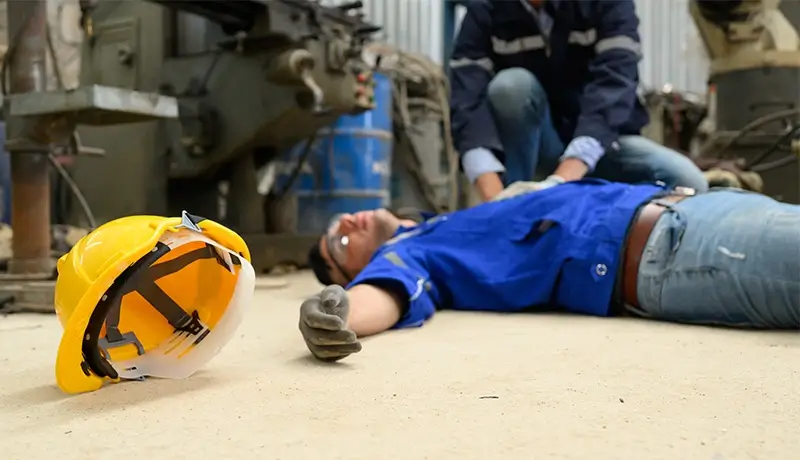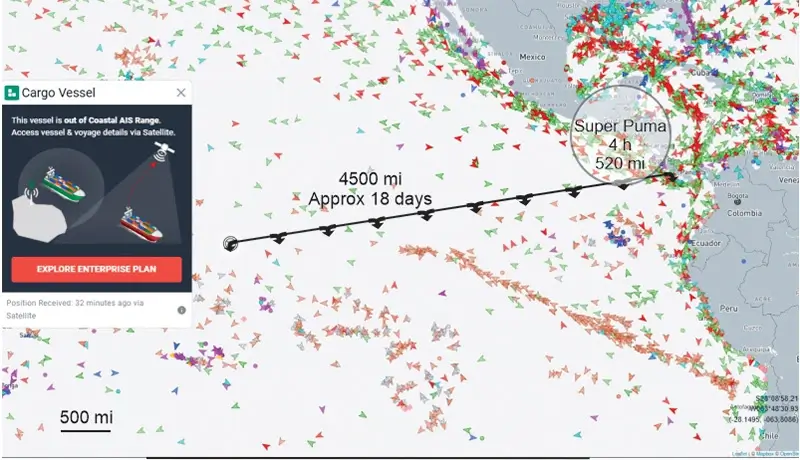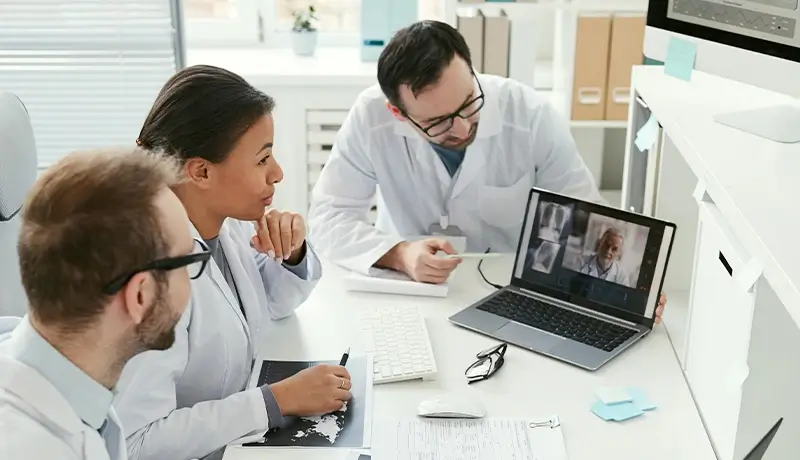Telemedicine for vessels
Telemedicine is the provision of medical assistance from a distance through telecommunications. The simplest form of telemedicine is communication between a doctor and a patient for providing medical advice.
However, this approach has limited usefulness for a commercial vessel navigating the oceans. The requirements for effective telemedicine on an ocean-going vessel are considerably high.
Highly comprehensive telemedicine systems are required to be effective in every situation.
Let’s look at some examples.
Example 1: (Relatively Short Distance from the Coastline)
A cargo ship is sailing loaded at a course of 30 degrees towards Rio de Janeiro at a speed of 13 knots, 400 miles away from its destination.
Due to rough seas, an object shifts and crushes a sailor’s chest. The injured sailor experiences intense chest pain, shortness of breath, and a fainting sensation.

Possible scenarios:
-
-
- Simple musculoskeletal injuries without clinical significance
- Rib fractures without complications
- Pneumothorax without tension
-
- Tension pneumothorax
- Hemothorax
The ship, at its current speed, will need 30 hours to reach its destination, plus at least 3 more hours for the patient’s disembarkation, road transfer to a hospital, and diagnostic testing—a total of at least 33 hours. If the captain increases the speed to 20 knots, the time will be reduced by 10 hours, with an additional fuel cost of 14,000 USD.

If the ship is 200 miles away from a helicopter departure point, it would take 0.5-3 hours for takeoff (depending on the crew’s readiness), 3 hours for the patient’s transfer, and another 1 hour for hospital care—a total of 5-6 hours.
In cases 1 and 2 above, none of this is needed. The sailor simply needs rest and painkillers.
In case 4 (tension pneumothorax), the poor sailor has very little chance of survival unless immediate and correct actions are taken through telemedicine, such as:
- The availability of an X-ray machine
- The maritime medic being trained in its use
- The maritime medic identifying pneumothorax on the X-ray
- Thoracic surgeons at the central station confirming tension pneumothorax and the need for immediate Bulaw placement
- The maritime medic being highly skilled in the surgical technique of Bulaw insertion through intensive training on animal cadavers

- The successful placement of the Bulaw by the maritime medic
- Confirmation of the correct Bulaw position with a follow-up X-ray
- The maritime medic, in cooperation with thoracic surgeons, monitoring the Bulaw’s functionality until the patient is safely transferred to a hospital for continued care.
Outcomes:
- The sailor’s life is saved.
- The ship continues on its scheduled course.
- The cost of on-board treatment is less than 100 USD.
Example 2: (Long Distance from the Coastline)
A VLCC tanker is sailing loaded on a course of 75 degrees at a speed of 10 knots towards the Panama Canal, 4,500 miles from its destination.
A sailor experiences intense abdominal pain that worsens progressively, does not fluctuate, intensifies with any movement (even breathing), and is accompanied by fever.

Possible scenarios:
- Kidney colic
- Bowel colic from constipation
- Acute gastroenteritis
- Herpes zoster before pimples appearance
- Acute appendicitis
The ship, at its current speed, will need 18 days to reach its destination. If the captain increases the speed to 15 knots, the time will be reduced by 6.25 days, with an additional fuel cost of 412,500 USD!
A Super Puma helicopter (the only one with 8-hour autonomy without refueling) can only reach the patient within 500 miles from the takeoff point.

Among the five possible diagnoses, the only life-threatening condition is acute appendicitis. The sailor would likely die within the next 2-3 days unless proper actions are taken via telemedicine, such as:
- The maritime medic being proficient in performing a physical examination to provide reliable information to the central station surgeons
- The availability of a blood analyzer on board
- The maritime medic being capable of drawing blood even from patients with “hidden” veins
- Upon diagnosing acute appendicitis, the sailor should receive powerful intravenous antibiotics to reach a hospital alive for surgery
- The maritime medic placing an IV line even under the difficult condition of septic shock, where veins “disappear,” requiring advanced skills in venipuncture in challenging situations
- The maritime medic being trained in the safe and aseptic handling of medication solutions and IV line connections
- The maritime medic monitoring the clinical progress and lab findings, adjusting the treatment per the central station surgeons’ guidance.
Outcomes:
- The sailor’s life is saved.
- The ship continues on its scheduled course.
- The cost of on-board treatment is less than 300 USD.
The Components of a Successful Telemedicine Setup
For telemedicine to work efficiently, you need certain key components in place:
-
Reliable Internet Connection: A strong, stable, high-speed internet connection is crucial for both healthcare providers and patients. Telemedicine relies on video conferencing, data transmission, and real-time communication, which all require a reliable connection to avoid disruptions.
-
Telemedicine Platform/Software: This is the central tool that facilitates communication between the doctor and the patient. The platform should be secure (HIPAA-compliant if in the U.S.), easy to use, and feature functions like video calls, messaging, file sharing, and appointment scheduling.
-
Medical Devices for Remote Monitoring: Devices like digital stethoscopes, blood analyzers, X-ray and ultrasound machines, blood pressure monitors, glucose meters, and pulse oximeters allow healthcare providers to monitor patients’ vital signs remotely. These can transmit data directly to the telemedicine platform.
-
Audio/Video Equipment: High-quality cameras and microphones ensure clear communication between patient and provider. This is especially important for diagnosing visual or auditory conditions.
-
Data Security: Patient confidentiality is essential in telemedicine. Strong encryption, two-factor authentication, and secure data storage must be in place to comply with privacy laws and protect sensitive medical information.
-
Mobile Access: Many patients prefer accessing telemedicine services via smartphones. Your platform should be optimized for mobile devices to ensure accessibility and convenience.
-
Training for Healthcare Providers: Medical staff need training to effectively use telemedicine technology. They should be comfortable navigating the software, operating remote monitoring devices, and troubleshooting minor tech issues.
-
Tech Support: Both patients and providers will need access to technical support in case any issues arise during a telemedicine session. Offering this ensures that issues are resolved quickly without disrupting patient care.
Reliable Telemedicine Service
Ensure that your vessel connects to a trusted telemedicine center. Choose a provider that operates 24/7 and specializes in maritime healthcare.
State-of-the-Art Telemedicine Equipment
The telemedicine unit on your vessel must include modern medical devices. It also needs reliable communication tools to ensure quick and accurate diagnosis and treatment.
Properly Trained Crew
A trained crew member is vital for telemedicine success. This person will communicate with the remote medical team and follow their guidance to treat the patient on board.
How Much Can Telemedicine Save You?
Telemedicine can save you a significant amount of money. By avoiding medical evacuations, preventing delays, lowering insurance premiums, and increasing crew retention, you can save tens of thousands of dollars per incident.
Telemedicine is not just about crew health. It improves your vessel’s operational efficiency and cuts costs. By investing in telemedicine systems, trained personnel, and quality equipment, you will see positive results both in terms of safety and your bottom line.
Equip your vessels with reliable telemedicine solutions today, and let your crew sail with confidence knowing that expert medical help is always available.
Frequently Asked Questions
-
What are the key requirements for a successful telemedicine system on a vessel?
- Reliable internet connection
- Modern remote monitoring medical devices
- Staff training in telemedicine technologies
- Ensuring patient data security
-
What are the main challenges faced by vessels when using telemedicine?
- Limited internet connection duration away from the shore
- Lack of specialized medical staff on board
- The need for quick and accurate diagnosis and intervention in remote locations
-
How can telemedicine help reduce costs for shipping companies?
- Avoiding medical evacuations and delays
- Reducing insurance premiums
- Improving crew performance and safety, thereby reducing accident-related expenses

